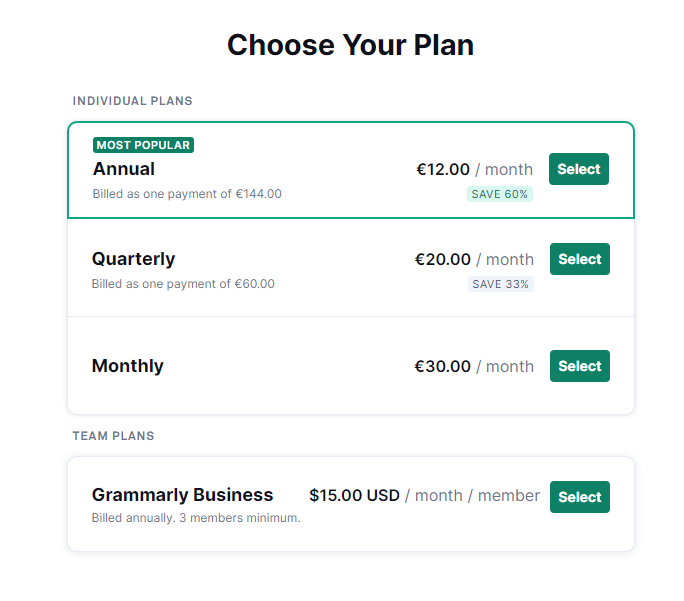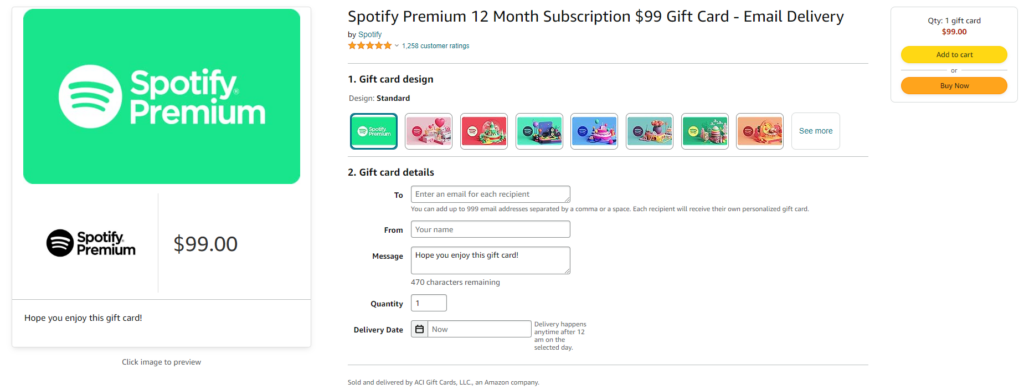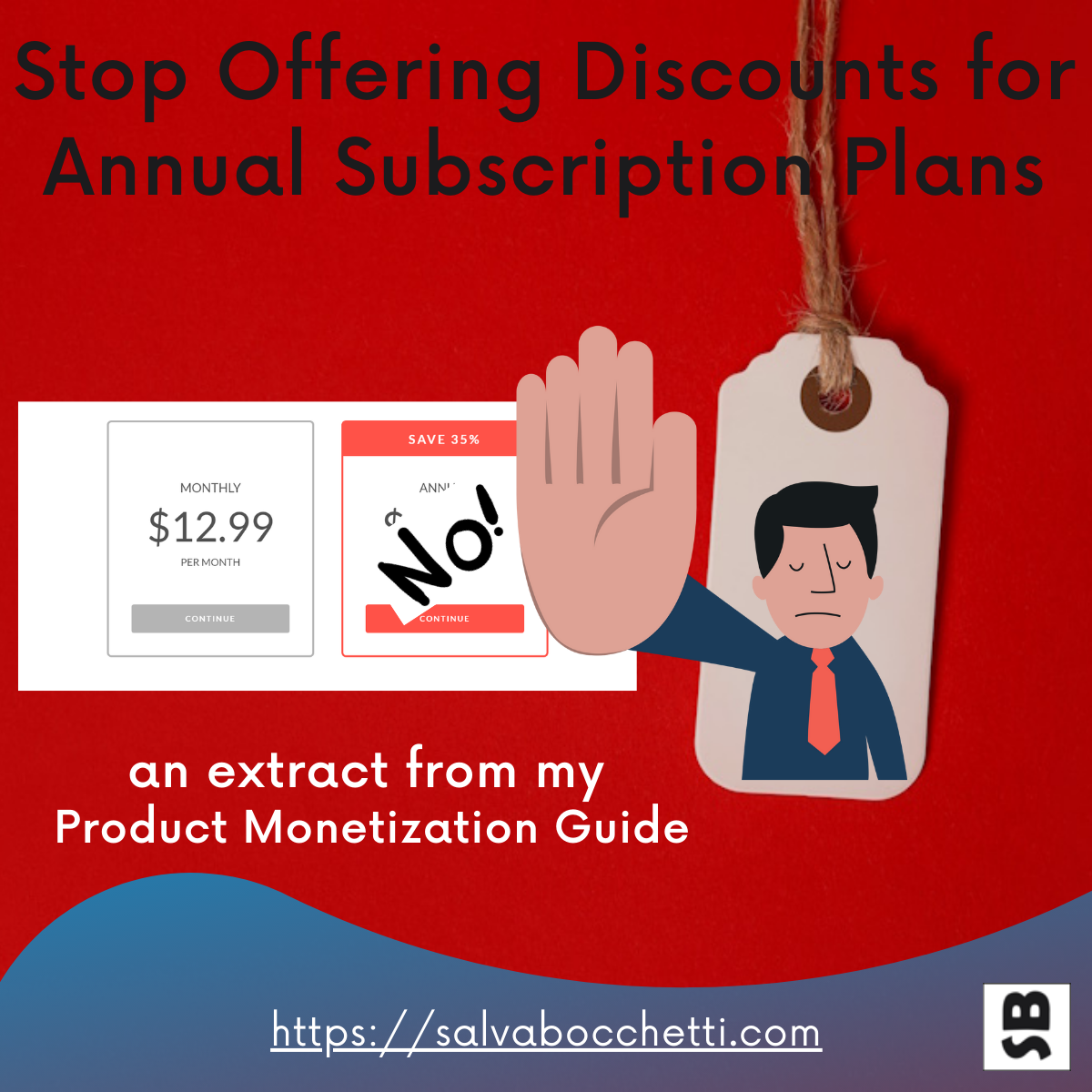Stop Offering Discounts for Annual Subscription Plans
Why Discounted Annual Plans are bad for revenue and for retention, and move you away from Value-Based Pricing
If you’re familiar with the SaaS market and online services, you’ve likely noticed the common practice of offering the same service at different price points based on the contract duration.
To be clear, I’m not referring to discretional discounts, nor to any generic promotions or rebates. In this context, I am talking about the discounts that many companies provide on their annual service plans compared to monthly ones. These discounts are usually given in exchange for a longer commitment and a pre-payment for the full yearly amount.
For example, you would buy the same service at $9/month if purchasing monthly, or $90 for the full year. This would represent a bit more than $7/month, or a discount of 20% compared to the monthly option.
But have you ever wondered why these annual discounts are so popular? Have annual discounts become a must, just because “everybody does it”? And is it really a good idea?
It may seem counterintuitive, but by offering discounts for annual subscription commitments, you’re losing money in the long term AND getting less loyal customers.
In the following paragraphs, I’ll explore the reasons why companies discount their annual plans compared to the monthly ones and show you that while there are some legitimate reasons for rewarding longer-term commitments, the drawbacks often outweigh the benefits, leading to potential negative consequences for your customers and your business.
While many companies strive for “value-based pricing” as a better way to monetize their products and services, we will see how in many cases discounted annual plans are the opposite of value-based pricing!
Why do companies provide annual discounts?
We saw annual discounts for yearly plans appearing in mass at the same time when a certain number of “10 bucks per month” services were born. At $10/month, the full price would have led to a $120/year bill. With a 20% discount on the yearly plan, it was then possible to hit a $99/year price point, just below a psychological threshold of $100.
However, the main reasons why companies provide substantial discounts on their annual plans with the intent of moving their users to longer commitments options are:
- Cashflow: Offering discounted annual plans allows companies to ask for 12 months’ worth of prepayment, effectively having the user’s money in their pocket for 6 months longer than with monthly payments. This approach helps finance the business without relying on traditional financing or fundraising.
- Retention: The idea behind annual plans is that they lead to less churn among customers. While this is partially true for the duration of the annual commitment, experience shows that churn rates can spike at the end of the commitment, sometimes even surpassing those of monthly subscriptions.
There are several compelling reasons NOT to discount your annual plans
On the other hand, there are plenty of reasons why you should NOT provide a discounted price for your annual subscription plans:
- Revenue Loss: Well that’s probably the most obvious reason. By offering annual discounts, you’re essentially giving up 20% of your revenue. While you may be trying to retain customers, the only thing that will happen for sure is that product effectively works for free during the months of November and December! That’s why we’re declaring October 30th the world annual plan discount day. Is this really your only option to retain customers?
- Preaching to the choir: Customers committing to annual plans are often those who already value your product and want to secure it in the long run. By discounting annual subscriptions, you’re discounting to the users who see the most value: in other words, you’re moving away from value-based pricing.
- Low hook: Offering significant discounts on annual plans might create a price point that customers get hooked to. This will create challenges in selling the monthly (full-price) version. Even if you’re aiming at selling the yearly plan to some of your customers, by hooking customers on a low price (as in yearly) you’re taking a serious risk on the ones that are genuinely interested in the monthly. This may include people with a temporarily limited need or people who still need to appreciate the value of your product. Look at the example from Grammarly below: once you’ve seen the whopping 60% discount on the annual plans, how would you feel about paying “full price”? It would be “crazy” to pay $30/month when you know that many people are getting it at $12/month, right? So what are your options: if you know you need it for one year, yeah 12$ is a good deal. But if you need it for less, you either agree to pay 144 $ and get a full year or you risk feeling “scammed” by paying more than double than the others for a monthly option. As you can see, framed this way, none of the two options is really appealing. Add to this that Grammarly is NOT giving out any full trial on its PRO plan (more about Free Trials later) and you see why this may be a big shoot in your feet.

- Complexity: You’re creating monthly and annual plans with the objective of getting a “healthy take rate” between the two. However, your highest risk is people who just find the choice too complex and chose… none of the two!
- Lock-in perception: Some customers may only need your service for a short period, and forcing them into a higher-priced annual plan can come across as trying to lock them in, leading to customer dissatisfaction (especially if the difference is high, as in the case of Grammarly). Also, they may wonder if a lock-in is your only way to secure customers, with a bad effect on trust.
- The hidden value: There is more value in annual plans than meets the eye, such as the comfort of a single payment for a longer service period. Having the subscription set up and running for a longer term (especially if additional actions are required by the users, such as paying an invoice) is actually a benefit and value per se!
An extreme approach: charge more for long-term contracts!
One of the extreme examples I like to refer to is the one of the Swiss newspaper “Le Temps” which goes the extra mile. Have a look at their prices and see if you can spot anything “unusual”.

Yes, “Le Temps” actually charge a higher monthly fee for the annual than for the 6 monthly plan! And they even highlight the 6 months as the default choice! (To be honest, I believe they have recently changed their pricing model and this is their previous offering, but at the time I took this screenshot this was the offer for their digital subscriptions).
Alternatives to Annual Discounts:
So, are there alternative ways to deliver on the promises of discounted annual pricing (higher retention and cash flow), without incurring the pitfalls we’ve discussed?
Absolutely! First of all, let’s clarify this. I am not suggesting removing annual plans, but just the discounts that go with them. In other words, automatically renewing a monthly subscription and “pre-paid” annual options (at 12x the monthly price) are very valid options.
Consider the following alternative approaches to maintain customer loyalty and increase your ARR (Annual Recurring Revenue) and cash flow.
- Deliver value consistently, starting from the Free Trials: Use Free Trials to show the value of your product immediately to users. By the time they choose a subscription, they should be convinced of the consistent value they’ll receive throughout the year and have less resistance going into an annual subscription, without the need for a discount. Spotify doesn’t offer annual discounts anymore AND provides a full free trial with each plan.

- Create specific value for annual users. Offer additional features or benefits that cater specifically to annual subscribers, making the longer commitment even more appealing (for instance, “payment on invoice”)
- Adapt to your customer needs: Understand that some customers may not need a full year of service. Consider offering specific plans for shorter durations to address their needs beyond the shorter duration. Why not have a specific plan for them, with specifically tailored features for this segment of users? This would indeed be a good justification for a different price point!
- Be ready to “pause”: if your customer needs are seasonal, being able to put their annual subscription on pause may be an alternative way to discount it. No need for your service during the summer? Just make it easy to freeze the account for a fee or for a small fee, and ensure they’re back once they’re ready for it.
- Change the game, be fair!: Turn your fairness and flexibility into a selling point, be proud, and communicate about it. And if you have the feeling that this is not what “everybody is doing”, this means you have a wonderful differentiator at hand! That’s exactly what Mullvad VPN does in the crowded world of VPN providers.

- Be flexible: Yearly subscriptions are good value for the customers even without discounts. So, try to retain them with the quality of your product, but allow them to leave if they feel so. Knowing that you’re not making their lives miserable just because they want to cancel their plan, reassures those who want to come back in the future. You’re better off having a customer actively canceling their subscription and being able to understand why (and remediate, if possible) rather than locking them just to discover they will leave when it’s too late (at the end of the annual engagement). Seeing their intention to churn “early enough” still leaves enough room to test different price points, just like Envato does with a one-off 70% discount for the next billing cycle if you consider leaving.

- Charge by value, not duration: Explore alternative pricing models, such as usage-based pricing, for customers who need your service for a shorter duration but still derive significant value from it.
- Reverse the discount thinking: Rather than penalizing shorter durations, consider offering locked-in benefits and price guarantees to address customer risk aversion. Especially in this year, when price increases become a frequent exercise for companies, more than one will see value in being bound for longer at certain conditions.
A final note about Spotify
In this article, I mentioned more than once that Spotify does NOT offer anymore annual (discounted) subscriptions, which is indeed true.
However, there is indeed a way to get a “discounted” annual subscription from Spotify. The small catch is that this offer is not marketed as an annual subscription, but rather as a “gift card for a yearly subscription”, retailing at $99.

What is the difference and why isn’t Spotify discounting directly on their website?
- The Fence: With this process, there is an additional “hassle” the user has to go through. Not a huge barrier for the real price sensitives, this friction would discourage the less price-sensitive ones who may find buying a gift card on Amazon and then applying to a Spotify account … too much of a complexity “just to save a few dozen bucks per year”. An effective “fence” to tell price-sensitive and non-price-sensitive customers apart.
- The brand: Spotify does not advertise this as a discount code (as supermarkets do with their promotions) but rather as a “gift card”. To all the effects, a different product than the official subscription (even though the result is the same), this gift card allows Spotify to preserve the official plans and avoid coming across as “unfair” in their offers. Brilliant, really.
In conclusion:
While discounted annual plans may have short-term benefits like cash flow and retention, they can lead to long-term revenue loss and customer dissatisfaction.
The fact that many businesses are still using annual discounts is an opportunity to differentiate and see what works for you, rather than following the mass blindly.
I am not suggesting against annual plans, but I am urging any product manager, pricing manager, and business owner to carefully consider the other options they have to enhance customer loyalty and increase revenue without resorting to coercive measures such as lock-in or enticements as discounts.
Customers have different willingness to pay and sensitivity to prices: all of those you can address with different pricing strategies that allow for price discriminations, on other bases than the duration of the commitment.
Special Tip: get the FREE Product monetization Canva
Do you want a simple way to look at all the Pricing elements at once? Download the free Product Monetization Canvas

My name is Salva, I am a Product executive, helping tech companies discover, shape, and sell better Products. My work and writing are mainly about subscription models, product pricing, e-commerce/marketplaces, and creating top product organizations.
My superpower is to move between ambiguity (as in creativity, innovation, opportunity, and ‘thinking out of the box’) and structure (as in ‘getting things done’ and getting real impact).
I am firmly convinced that you can help others only if you have lived the same challenges: I have been lucky enough to practice product leadership in companies of different sizes and with different product maturity. Doing product right is hard: I felt the pain myself and developed my own methods to get to efficient product teams that produce meaningful work.

